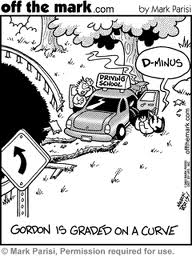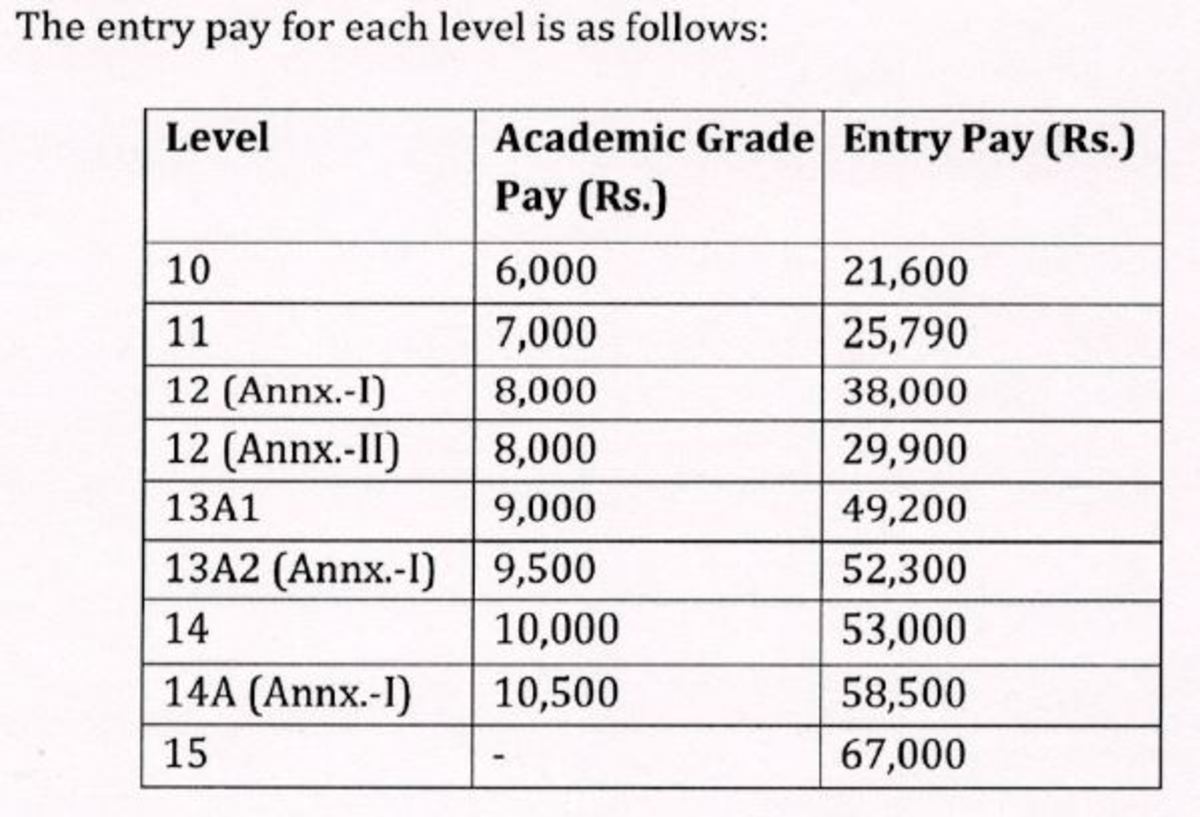Grading Community College Students, pt. 2

"Do You Grade on a Curve?"
My simple answer to the question posed in the subtitle is no. I have never understood the concept of basing a student’s grade on the performance of other people who happened to sign up for the same class. If you are unlucky enough to be surrounded by high achievers, you are penalized. If you happened to pick the class with the slackers and the “not-so-bright” students, you get rewarded. A wise student, once they realize that grades will be on a curve, should try to pick up the educational “vibe” in the classroom. When you notice signs of intelligence, you should quickly drop and try your luck elsewhere. If people resemble the typical students that you knew in high school, then you should stick around.
Still, I can understand why some teachers might go with the curve. One of the most challenging things for a teacher is finding the right level of difficulty for a class. A class must be challenging enough to compel students to show up, take notes, complete assignments, and study for tests. If students realize that they can cruise through with little effort, many will happily do so. On the other hand, if the class is too difficult, then students will be too overwhelmed, frustrated, or even traumatized to be successful. Large numbers of Americans have memories of school that are not particularly happy. And while schools have many creative ways of torturing students, it is their creation of the persistent fear and/or experience of failure that may be the worst. So how do I challenge students enough to force them to interact with the material while not scaring them away and/or being added to their list of painful memories?
Throughout my teaching career, I have continually “tweaked” my grading system in order to find the right balance. In part one of this little “series,” I talked about how and why I have given an increasing number of written assignments as my college career has progressed. This is partly because I realized that many students would not do assignments unless they received immediate points for them. I have also added an increasing number of assignments, however, to give them a better chance of getting a good grade. Pop quizzes, in-class assignments, and extra credit papers are easier than tests, so responsible students will use all of these opportunities to beef up their grade. I have also from the beginning of my community college career graded students for “class participation.” They get points for showing up on time, not disrupting class, and participating in class discussions. If they do negative things – absences, tardiness, class disruptions, or sleeping in an obvious fashion – points are taken away from their participation grade. For conscientious students, this almost always helps their grade. For students inclined to be irresponsible, class participation points can at least give them some incentive to show up. And in the end, students who get a bad participation grade due to a large number of absences were going to get a lousy overall grade anyway.
The majority of class points, however, are not easy. I have worked very hard over the years to create tests that are both challenging and fair. I do not try to trick students on my tests. In fact, I encourage students to try and predict the uncreative questions that I am likely to ask. I have a low tolerance, however, for B.S. Essay answers must make specific references to course material. I do not accept vague, general answers that could be written by a person who never entered my class. Multiple choice questions, when I use them, have five possible responses, and I am pretty good at writing answers that would sound plausible to a person who did not know any better. I can therefore say with some confidence that students cannot guess their way through my tests. I have seen many try, and it is not pretty. But if students know their stuff, then they will do well, and I have seen plenty of people ace my tests over the years. And if everyone in the class gets good test scores, then they should all be rewarded. But if people flake out and take the B.S. approach, then they will all get a failing score. Any other system makes no sense. A curve, in my view, is a teacher admitting that he or she is not qualified enough to come up with a grading system that has the right difficulty level.
Now some might argue that basing a person’s grade heavily on tests is a mistake. I somewhat agree. After all, how often do people in the “real world” have bosses who ask them to take timed exams purely from memory? The working world consists of the completion of projects, not the taking of tests. Still, in the world of school, tests are often the only way to determine accurately what an individual student knows. If the entire grade is based on take home projects, then it is impossible to know if students actually did the assignments themselves. Therefore, in our imperfect world, I am forced to resort to tests.
However, as mentioned earlier, I give students a chance to supplement tests with some easier assignments. This way, students who are not the greatest test takers in the world will at least have a shot at a passing grade. And because I am such an incredibly nice guy, I make my grading scale a bit more generous toward the bottom: 65% will get you a “C,” and 50% will “earn” you a “D”. At the top, however, you will need the standard 90% for an “A” and 80% for a “B”. Because tests are challenging, students who want that “A” will have to put out a decent effort to get the desired grade. But because of some easier quizzes and assignments (including extra credit), a grade boost for taking the time to show up consistently, and my more generous grading scale toward the bottom, less talented students of history who put out a reasonable effort will still have a chance for a passing grade.
I view my grading system as a tool designed to get students to interact with historical material. I want everyone to get a good grade, but passing students is not my primary goal. If I simply wanted everyone to pass, I would make the class really easy. By doing this, however, I would be neglecting my responsibility as a teacher, and I would be one more contributor to our nation’s epidemic of historical illiteracy. So anything that I can do to compel students to learn history is a legitimate grading tactic. The trick is to present material in effective ways and to create a grading system that is both fair and rigorous. After that, it’s up to them. And if they all get an “A,” then we are all happy. But if they all get an “F,” they aren’t going to get bailed out by the other poor students in the class.









